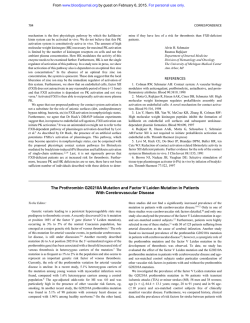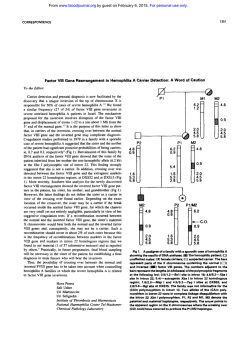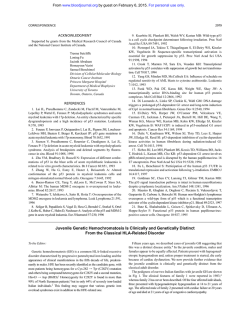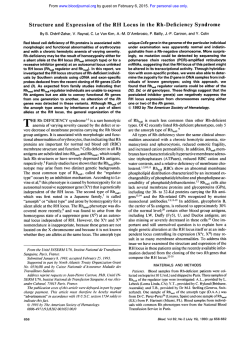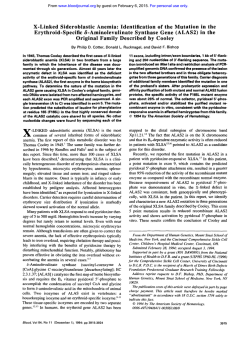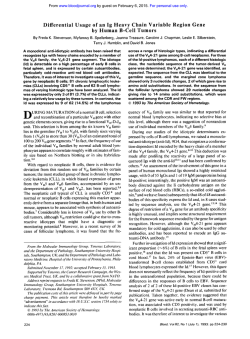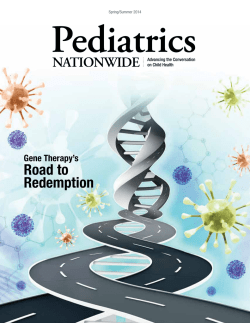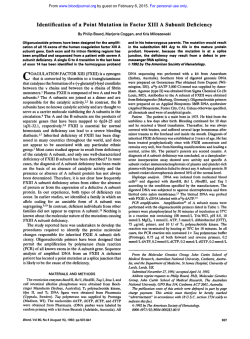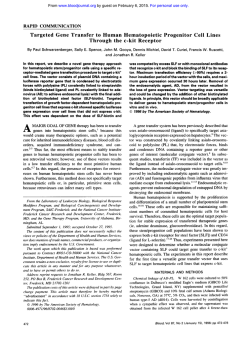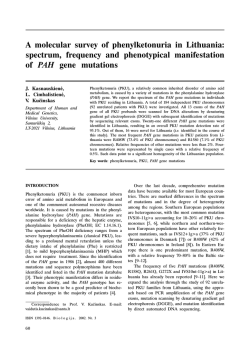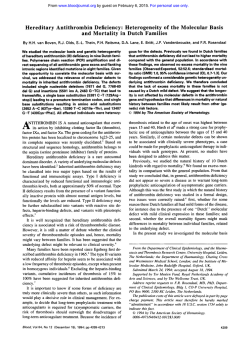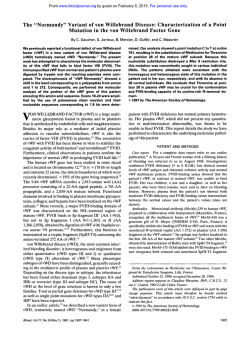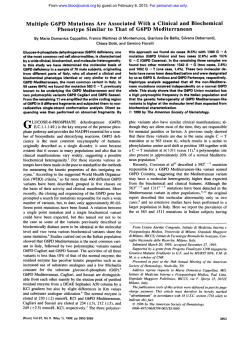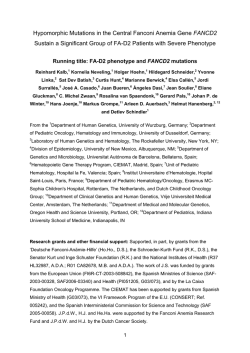
Busulfan Alone as Cytoreduction Before Autografting for Chronic
From www.bloodjournal.org by guest on February 6, 2015. For personal use only. CORRESPONDENCE Busulfan Alone as Cytoreduction Before Autografting for Chronic Myelogenous Leukemia To the Editor: A number of prospective randomized studies have recently been designed to address the question of whether autografting prolongs survival for patients with chronic myelogenous leukemia (CML) in chronic phase,1,2 but there is no general agreement as to the optimal approach to cytoreduction before transfusion of autologous stem cells. Table 1. Clinical Data on 37 Patients Autografted for CML With Busulfan Only as Cytoreduction No. of Patients (%) A Disease status at autograft CP CP2 AP BC Autograft method BM PBSC Mobilized PBSC MYB antisense* Vancouver† 28 (76) 2 (5) 6 (16) 1 (3) 5 (14) 8 (22) 11 (30) 4 (11) 9 (24) B Median Range Age at autograft (yr) Duration of disease at autograft (mos) Nucleated cell dose (ϫ108/kg) Duration of neutropenia (d) Duration of platelet support (d) Hospital stay (days) Interval from autograft to restarting anti-leukemic therapy (mos) 45.3 30.2 3.8 12.5 23 35 (20.8-56.7) (7.2-105.0) (0.7-12.3) (2-110) (0-158) (13-124) 4.5 (0.8-19.8) C Median 95% CI Survival from 1st autograft (yr) Survival from diagnosis (yr) 3.4 6.3 (1.7-5.9) (5.7-6.9) A: Disease status and autograft method; B: Age, duration of disease, and autograft details; C: Survival. Abbreviations: CP, chronic phase; CP2, second chronic phase after blastic transformation; AP, accelerated phase; BT, blastic transformation; BM, bone marrow; PBSC, peripheral blood stem cells. *Autograft performed with marrow cells incubated in vitro with a MYB antisense oligomer. †Autograft performed with marrow cells incubated for 10 days in liquid culture. We believe that the use of high-dose busulfan alone, as used in patients subjected to second allograft procedures,3 may be a good compromise between maximal cytoreduction and minimal regimen-related toxicity. A heterogeneous group of 37 patients with CML in different phases of CML were autografted at the Hammersmith Hospital in London over a 5-year period by using busulfan alone as cytoreduction (Table 1). The regimen consisted of 4 mg/kg/d busulfan orally for 4 consecutive days (total, 16 mg/kg). A loading dose of 1,000 mg oral phenytoin was administered 1 day before the start of chemotherapy and phenytoin was continued at a dose of 300 mg/d for 7 days to prevent epileptic seizures. Neither busulfan nor phenytoin levels were monitored. Autologous cells were infused 48 hours after the last dose of busulfan. All patients had some degree of stomatitis, but no other major toxicities4 were encountered (Table 2). Specifically, no patient had busulfan-related pulmonary toxicity, hepatic veno-occlusive disease, or epileptic seizures, and no patient experienced persisting alopecia. We did not formally compare the use of busulfan alone with that of other more intensive cytoreduction regimens. However, the complete/ major cytogenetic response rate at 3 months postautograft was 20% (6 patients) and the median survival postautograft was 3.4 years (95% confidence interval [CI]: 1.7 to 5.9) (Table 1). Thus, we can be reasonably confident that the use of this cytoreduction regimen produced results at least as good as those achieved with the combinations of busulfan plus cyclophosphamide or cyclophosphamide plus total body irradiation. The principal reason why busulfan alone might be preferable to more intensive regimens is simply the fact that it may achieve the same level of cytoreduction with less toxicity. Conversely, the fact that the cells used for the autograft usually contain at least some Phϩ progenitor cells such that relapse must originate at least partly from the autografted material5 might mean that the attempt at complete marrow ablation with maximal chemotherapy or chemoradiotherapy was not justified. Moreover, busulfan alone is relatively easy to administer and administration will become even more straightforward when the intravenous preparations now being developed become available for routine use. We conclude that if one chooses to autograft a patient with CML, then busulfan alone is a reasonable cytoreduction regimen associated with minimal toxicity which should still permit the possibility of a subsequent allograft or second autograft procedure. Stephen G. O’Brien John M. Goldman Department of Haematology Imperial College School of Medicine Hammersmith Hospital London, UK Table 2. Toxicity After Cytoreduction With Busulfan Alone in 37 Patients Autografted for CML Grade III or less Grade II or less Grade I only Total with any degree of toxicity Cardiac Bladder 0 0 0 0 0 0 0 0 Blood, Vol 91, No 3 (February 1), 1998: pp 1091-1097 Renal Respiratory Hepatic CNS Stomatitis Gastrointestinal 1 (3%) 2 (5%) 3 (8%) 0 0 0 0 1 (3%) 2 (5%) 0 0 0 0 28 (76%) 9 (24%) 0 0 5 (14%) 6 (16%) 0 3 (8%) 0 37 (100%) 5 (14%) 1091 From www.bloodjournal.org by guest on February 6, 2015. For personal use only. 1092 CORRESPONDENCE REFERENCES 1. Spencer A, O’Brien SG, Goldman JM: Options for therapy in chronic myeloid leukaemia. Br J Haematol 91:2, 1995 2. Bhatia R, Verfaillie CM, Miller JS, McGlave PB:Autologous transplantation for chronic myelogenous leukemia. Blood 89:2623, 1997 3. Cullis JO, Schwarer AP, Hughes TP, Hows JM, Franklin I, Morgenstern G, Goldman JM: Second transplants for patients with chronic myeloid leukaemia in relapse after original transplant with T-depleted donor marrow: Feasibility of using busulfan alone for re-conditioning. Br J Haematol 80:33, 1992 4. Bearman SI, Appelbaum FR, Buckner CD, Petersen FB, Fisher LD, Clift RA, Thomas ED: Regimen-related toxicity in patients undergoing bone marrow transplantation. J Clin Oncol 6:1562, 1988 5. Deisseroth AB, Zu Z, Claxton D, Hanania EG, Fu S, Ellerson D, Goldberg L, Thomas M, Janicek K, Anderson WF, Hester J, Korbling M, Durett A, Moen R, Berenson R, Heimfeld S, Hamer J, Calvert L, Tibbits P, Talpaz M, Kantarjan H, Champlin R, Reading C: Genetic marking shows that Phϩ cells present in autologous transplants of chronic myelogenous leukemia (CML) contribute to relapse after autologous bone marrow in CML. Blood 83:3068, 1994 The Prothrombin Gene 3Ј-Untranslated Region Mutation Is Frequently Associated With Factor V Leiden in Thrombophilic Patients and Shows Ethnic-Specific Variation in Allele Frequency To the Editor: As data accumulate on the recently identified genetic variant in the 3Ј-untranslated region of the prothrombin (factor II) gene (G20210A), it is apparent that this mutation confers a moderate risk for venous thrombosis.1-3 Data from several abstracts presented at the 1997 ISTH meeting in Florence, Italy and a recent manuscript from Dr Rosendaal and coworkers, which revealed an association of this genetic variant with an increased risk of myocardial infarction in young women, suggest that an ethnic-specific variability in the frequency of the prothrombin gene mutation exists in healthy controls from European populations, analogous to that reported for factor V Leiden.3-5 The ethnic distribution frequency of the G20210A mutation in Americans has not yet been reported. In addition, as pointed out in a recent letter to BLOOD summarizing results from a moderate size study of French families, an increased cosegregation frequency of heterozygosity for the prothrombin gene mutation and carriership for factor V Leiden in families with hereditary thrombophilia has not unequivocally been shown. In contrast to data obtained from the Dutch population,1 the French study showed that the prothrombin gene A20210 allele is not frequently found in their thrombophilic families carrying the Leiden allele of the factor V gene.6 In fact, none of the probands or family members had the prothrombin gene mutation. Therefore, the hypothesis that cosegregation of the prothrombin gene mutation and heterozygosity for activated protein C resistance results in increased expressivity of hypercoagulability and thrombophilia within these families remains unproved. We investigated the frequency of the prothrombin gene mutation in consecutive thrombosis patients at Emory Hospital (Atlanta, GA). Seventy-two out of 477 thrombosis patients were found to be heterozygous for factor V Leiden (15.1%) and 4 were homozygous (0.84%). Genomic DNA samples were available for 48 of these 76 thrombosis patients that were either heterozygous or homozygous for factor V Leiden. The factor II gene mutation was identified in 5 of these 48 patients (10.4%). Out of 278 apparently healthy subjects, we identified the prothrombin gene variant in 7 (2.5%). These data are comparable to that found in the Dutch population (2.3% in a population-based case/control study and 1% in healthy controls). Although not representing a family study, our data does suggest that the coexistence of these two prothrombotic genetic variants may increase the clinical expressivity of thrombophilia and thus provides further validation of the ‘‘double hit’’ theory as a mechanism of thrombophilia in the younger patient. Interestingly, as reported for the factor V Leiden mutation, the frequency of the G20210A mutation was very rare in African Americans. In fact, none of the 52 healthy African Americans in our study carried the prothrombin mutation and none of the 5 thrombosis patients who were double heterozygotes for the factor II and V variants were of African ancestry. We conclude that in our population, the G20210A prothrombin allele is frequently associated with activated protein C resistance and most likely confers an increased thrombosis risk for these individuals. In addition, a better understanding of the apparent ethnic-specific variability of the factor II gene mutation should help to provide better diagnostic algorithms that optimize cost-effective laboratory evaluation of the thrombophilic patient. Tom E. Howard Mira Marusa Jody Boisza Andrew Young Judy Sequeira Cindy Channell Cindy Guy Elizabeth Benson Alexander Duncan Department of Pathology and Laboratory Medicine Emory University Hospital Atlanta, GA REFERENCES 1. Poort RS, Rosendaal FR, Reitsma PH, Bertina RM: A common genetic variation in the 3Ј-untranslated region of the prothrombin gene is associated with elevated plasma prothrombin levels and an increase in venous thrombosis. Blood 88:3699, 1996 2. Howard TE, Marusa M, Channell C, Duncan A: A patient homozygous for a mutation in the prothrombin gene 3Ј-untranslated region associated with massive thrombosis. Blood Coagul Fibrinolysis 8:316, 1997 3. Rosendaal FR, Siscovick DS, Schwartz SM, Psaty BM, Raghunathan TE, Vos HL: A common prothrombin variant (20210 G to A) increases the risk of myocardial infarction in young women. Blood 90:1747, 1997 4. Ferraresi P, Legnani C, Quaglio E, Castoldi E, Marchetti G, Palareti G, Bernardi F: Study of a G/A variation in the 3Ј untranslated region of prothrombin mRNA in Italian patients with venous thrombosis. Thromb Haemost 77:379, 1997 (abstr, suppl) 5. Ridker PM, Miletich JP, Hennekens CH, Buring JE: Ethnic distribution of factor V Leiden in 4047 men and women. JAMA 277:1305, 1997 6. Alhenc-Gelas M, Le Cam-Duchez V, Emmerich J, Frebourg T, Fiessinger J-N, Borg J-Y, Aiach M: The A20210 allele of the prothrombin gene is not frequently associated with the factor V Arg 506 to Gln mutation in thrombophilic patients. Blood 90:1711, 1997 From www.bloodjournal.org by guest on February 6, 2015. For personal use only. 1998 91: 1091-1092 Busulfan Alone as Cytoreduction Before Autografting for Chronic Myelogenous Leukemia Stephen G. O' Brien and John M. Goldman Updated information and services can be found at: http://www.bloodjournal.org/content/91/3/1091.full.html Articles on similar topics can be found in the following Blood collections Information about reproducing this article in parts or in its entirety may be found online at: http://www.bloodjournal.org/site/misc/rights.xhtml#repub_requests Information about ordering reprints may be found online at: http://www.bloodjournal.org/site/misc/rights.xhtml#reprints Information about subscriptions and ASH membership may be found online at: http://www.bloodjournal.org/site/subscriptions/index.xhtml Blood (print ISSN 0006-4971, online ISSN 1528-0020), is published weekly by the American Society of Hematology, 2021 L St, NW, Suite 900, Washington DC 20036. Copyright 2011 by The American Society of Hematology; all rights reserved.
© Copyright 2025
